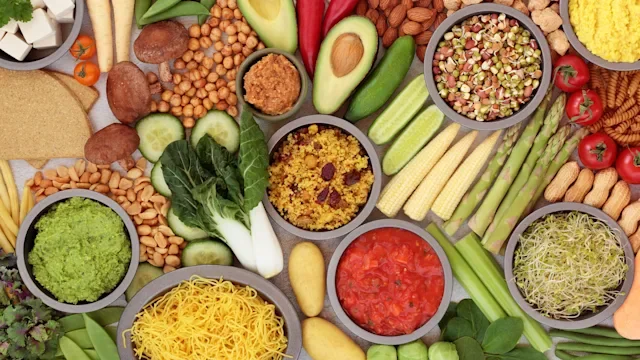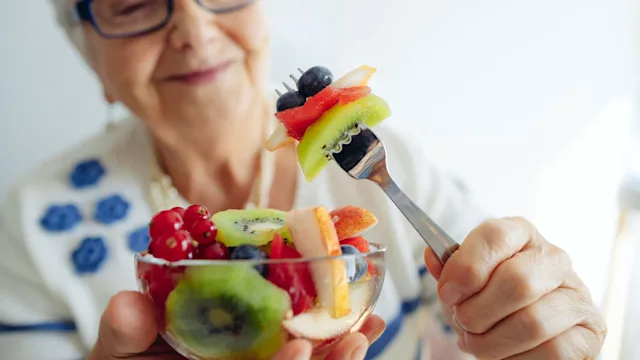Key takeaways:
Oatmeal is a healthy way to start the day. It’s high in fiber, which is good for digestive health and cholesterol levels.
Oatmeal isn’t high in protein, an important nutrient to have at breakfast. A half cup serving only has about 5 g. It’s best to aim for about 20 g of protein at breakfast.
It’s easy to add protein to your morning oatmeal with foods like nuts, seeds, eggs, yogurt, protein powder, tofu, cottage cheese, and peanut butter. These foods can double to triple the amount of protein in your breakfast.
A bowl of oatmeal has been a popular breakfast staple around the world for thousands of years. It’s versatile, convenient, and can be prepared in a lot of different ways. Oatmeal is a whole grain and a good source of fiber, which is why it’s associated with improved digestive and heart health. But it’s not the best source of protein.
Eating more protein at breakfast may help you feel full for longer, maintain muscle mass as you age, and achieve your desired weight. So in this article we share delicious and filling ways to increase the protein in your morning oatmeal.
Quiz: What should I eat for breakfast?
How much protein is there in oatmeal?
This depends on the kind of oatmeal. The three most common types of oatmeal are listed below, along with their nutrition facts. Most oatmeal on the market today provides similar nutrients, but differ in serving size and preparation method.
| Steel-cut oats | Old-fashioned oats | Instant oatmeal |
|---|---|---|
| Prep: Bring water to a boil and cook for 25-30 minutes. | Prep: Bring water to a boil and cook for 3-5 minutes. | Prep: Combine water with instant oats and microwave for 90 seconds. |
| Nutrition facts:
¼ cup serving
|
Nutrition facts:
½ cup serving
|
Nutrition facts:
1 packet
|
Steel-cut oats (also called Irish oats) are not flattened during processing. This means they require the longest prep time. It can take up to 30 minutes to prepare steel-cut oats, which is similar to other minimally processed whole grains like wild rice and quinoa.
Old-fashioned oats are steamed and flattened before packaging, which is why they require less cook time.
Instant oatmeal processing takes it a step further — they’re both precooked and dried. It’s important to note that many instant oatmeals at restaurants and on grocery shelves contain added sugars. And some newer offerings even come with protein already added.
Ways to add protein to oatmeal
Oatmeal is a good way to start the day, and adding protein can make it even better. A study that included more than 10,000 adults found that higher-protein breakfasts (between 10 g and 23 g) were associated with improved blood pressure and cholesterol levels.
Your individual protein needs are unique to you and your life stage. But many groups of people may benefit from higher protein intake, which helps maintain or build muscle mass. This includes older adults, athletes, and people with weight-loss or weight-maintenance goals.
1. Prepare it with milk
A cup of milk adds 8 g of protein.
A simple way to add more protein to your oatmeal is using milk instead of water. In addition to adding protein, milk provides a good or excellent source of 12 other essential nutrients — including calcium, vitamin D, iodine, and more. You can use a milk with the fat level of your choice, or opt for a lactose-free variety if you have symptoms of lactose intolerance.
What makes a healthy breakfast? You don’t have to eat the same thing every morning. A dietitian walks you through a formula to build a healthy breakfast.
Steel-cut oats vs. rolled oats: Have you ever wondered what the difference is? We go through the pros and cons of both oatmeal varieties.
Are you getting enough protein? Many different factors play into how much you need each day. Here’s how to calculate your individual needs.
Eight ounces of reduced-fat milk have:
123 calories
8 g of protein
12 g of carbohydrates
5 g of fat
0 g of fiber
2. Add protein powder
A scoop of whey or soy protein powder adds 13 g of protein.
Read more like this
Explore these related articles, suggested for readers like you.
Protein powders aren’t only for frequent gym-goers. They’re easy to store in your pantry, and add to the foods you already eat.
Different powders will use different sources of protein. According to a protein rating system, both whey protein and soy protein receive the top scores for protein quality (they both get a score of 1 out of 1). As a comparison, pea protein gets a score of 0.89, and rice protein gets a score of 0.41.
Protein quality is important. But so is finding a powder you like and use. Many retailers sell small packets of protein powder so you can test to see which flavors and brands you prefer.
In general, about one scoop of whey protein powder adds about:
75 calories
13 g of protein
4 g of carbohydrates
0 g of fiber
1 g
The added sugar and other ingredients are variable, so it’s important to check the supplement facts panel to know what you’re getting.
3. Stir in peanut butter
Two tablespoons of peanut butter add 7 g of protein.
Peanut butter is a pantry staple in many households in the U.S. And it adds healthy fats and great flavor to any bowl of oatmeal. Two tablespoons of peanut butter (or about the size of a golf ball) provide about:
188 calories
7 g of protein
8 g of carbohydrate
2 g of fiber
16 g of fat (a blend of the healthy fats)
Since fat has the highest number of calories per gram (compared with protein and carbohydrates), a little goes a long way. Healthy fats are also important to include in your meals because they help you to absorb certain vitamins and nutrients from the foods you eat. For a lower-calorie option, you can try powdered peanut butter. It provides 6 g of protein and 60 calories for a 2 tbsp serving.
4. Add chia seeds
One tablespoon of chia seeds adds 4 g of protein.
Chia seeds are a good source of fiber, but they can also add a protein boost to a bowl of oatmeal.
One ounce of chia seeds (about the size of a golf ball) provides:
120 calories
4 g of protein
7 g of fat
10 g of carbohydrates
8 g of fiber
Yes, you read that right, 8 g of fiber! So you may want to start with a smaller serving of chia seeds to avoid any unwanted digestive issues.
Chia seeds are also one of the few plant-based sources of omega-3 fatty acids. These are healthy fats that can reduce inflammation in the body and support brain health.
Unless you like a little crunch in your oats, it’s also helpful to soak them first. When you put them in milk or water for about 20 minutes, they swell up and turn gel-like.
5. Add some nuts
One serving of pistachios or almonds adds 6 g of plant-powered protein.
Nuts are a great way to add protein, fiber, and healthy fats to your oatmeal. Almonds and pistachios have the highest protein content of any nut.
One ounce of almonds (23 almonds) adds:
170 calories
6 g of protein
15 g of fat
6 g of carbohydrate
3 g of fiber
One ounce of pistachios (49 pistachios) provides:
151 calories
5.7 g of protein
13.2 g of fat
7.6 g of carbohydrate
3 g of fiber
Nuts and nut butters are both calorie and nutrient dense, which means they pack a lot of nutrition (and calories) into a small amount. Sliced almonds, crushed pistachios, or nut butters make delicious additions to a bowl of oatmeal. But you can add any nut that you prefer. And try rounding out your nutty oatmeal with cinnamon and puréed pumpkin or fresh berries for extra flavor and nutrients.
6. Add eggs
One egg adds 6 g of high-quality protein.
Adding eggs to oatmeal makes for a savory breakfast combination. For under 100 calories, one egg provides:
72 calories
6.3 g of high-quality protein
5 g of fat
0.36 g of carbohydrates
0 g of fiber
Eggs are considered a complete protein. This means they provide all nine essential amino acids (the building blocks of protein). They also contain crucial nutrients including iodine and choline, which can be difficult to source from other foods.
Start out with plain instant oats then add water or milk, and then add an egg. Whisk the egg into the oatmeal mixture and microwave for 2 to 3 minutes. Try adding green onions or cheese to the top.
7. Stir in some yogurt
Yogurt adds 6 g to 15 g of protein depending on the type.
Similar to eggs, yogurt is a source of high-quality protein. Yogurt’s protein content varies depending on how it was processed, ranging from 6 g to 15 g of protein per container. Both Greek- and Icelandic-style yogurts provide higher protein (and a thicker consistency) than traditional yogurt.
Greek yogurt provides:
165 calories
15.3 g of protein
8.5 g of fat
7 g of carbohydrate
0 g of fiber
Regular yogurt is also a great way to boost the health benefits of your oatmeal and adds:
104 calories
6 g of protein
5.5 g of fat
8 g of carbohydrate
0 g of fiber
Yogurt is also a fermented food, which provides additional beneficial bacteria that supports gut health. The fermentation process also reduces the lactose content of yogurt. While all yogurt is fermented, some varieties have added probiotics. These are live microorganisms that can provide additional benefits beyond digestive health.
8. Cottage cheese
A half a cup of cottage cheese adds 12 g of protein.
Cottage cheese has increased in popularity in recent years. That is probably because of its versatility and its high-quality protein content. Add it to a savory bowl of oatmeal with eggs and sautéed onions and peppers. Or it makes a great sweet bowl with berries and cinnamon.
A half cup of cottage cheese provides:
103 calories
12 g of protein
4.5 g of fat
3.5 g of carbohydrate
0 g of fiber
9. Sunflower seed butter
Two tablespoons of sunflower butter provides 6 g of protein.
Similar to peanut butter, seed butters add protein and creaminess to oatmeal. Sunflower seeds are excellent sources of selenium, vitamin E, antioxidants, and heart-healthy unsaturated fats. They are also safe for people with food allergies to tree nuts and peanuts.
Two tablespoons of sunflower butter provides:
197 calories
5.5 g of protein
18 g of fat
7.5 g of carbohydrate
2 g of fiber
10. Tofu
Silken tofu provides 5 g of protein per 3 oz serving.
Tofu is surprisingly versatile, and there are multiple different kinds. Silken tofu is a good option that is creamy and easy to stir into your morning oats.
Three ounces of tofu provide:
50 calories
5 g of protein
2.5 g of fat
2 g of carbohydrate
0 g of fiber
High-protein overnight oats
There’s an unlimited number of oatmeal combinations that can boost the protein and flavor of your breakfast. Overnight oats is a great way to bump up the protein in your breakfast. And you can make it in advance to save you some time in the morning.
Peanut butter banana overnight oats
Makes 4 servings
Ingredients:
2 cups of old-fashioned rolled oats
1.5 cups of whole milk
1 oz to 6 oz container of Icelandic yogurt
1 scoop of unflavored whey protein powder
2 tbsp of peanut butter
1 tsp of cinnamon
2 bananas
Instructions:
Combine rolled oats, whole milk, yogurt, protein powder, peanut butter, and cinnamon. Pour into four jars in even portions.
Refrigerate overnight for at least 8 hours.
Top with sliced banana. Enjoy!
Each serving gives you:
359 calories
19 g of protein
10 g of fat
50 g of carbohydrate
6 g of fiber
Added sugar and salt are variable depending on the brands you purchase. Between the peanut butter, cinnamon, milk, and banana, you may not need any additional sugar.
Frequently asked questions
Oatmeal provides between 3 g and 5 g of fiber per serving. It’s considered a good source of fiber. Adding nuts, berries, or seeds can add more fiber.
Plain oatmeal is bland, so you can make it sweet or savory. To make a savory oatmeal, start with plain oatmeal and add your liquid of choice according to instructions on the package. Before microwaving or baking, add an egg, diced onion, and peppers. Once it’s cooked and warm, you can top it with shredded cheese or cottage cheese.
Mix old-fashioned oats, eggs, cottage cheese, milk, and vegetables of your choice together in a mixing bowl. Pour the mix into an oven-safe dish. Bake for 20 to 30 minutes at 350°F (177°C) until fully cooked. You can also make a sweet version. Mix oats, eggs, milk, fruit, and nuts of your choice. Then bake the same way.
Oatmeal is a part of the grain food group. While it does contain carbohydrates, it’s a whole grain. Whole grains provide high-quality nutrients like fiber, iron, and B vitamins. Opt for whole grains over refined grains when possible.
Oatmeal provides between 3 g and 5 g of fiber per serving. It’s considered a good source of fiber. Adding nuts, berries, or seeds can add more fiber.
Plain oatmeal is bland, so you can make it sweet or savory. To make a savory oatmeal, start with plain oatmeal and add your liquid of choice according to instructions on the package. Before microwaving or baking, add an egg, diced onion, and peppers. Once it’s cooked and warm, you can top it with shredded cheese or cottage cheese.
Mix old-fashioned oats, eggs, cottage cheese, milk, and vegetables of your choice together in a mixing bowl. Pour the mix into an oven-safe dish. Bake for 20 to 30 minutes at 350°F (177°C) until fully cooked. You can also make a sweet version. Mix oats, eggs, milk, fruit, and nuts of your choice. Then bake the same way.
Oatmeal is a part of the grain food group. While it does contain carbohydrates, it’s a whole grain. Whole grains provide high-quality nutrients like fiber, iron, and B vitamins. Opt for whole grains over refined grains when possible.
The bottom line
Oatmeal is a great way to start the day. But if it leaves you feeling hungry just a couple of hours later — or if you’re looking for ways to increase your protein intake — experiment with different additions to your oatmeal. Foods like nuts, eggs, protein powder, or dairy products can double or triple the protein content of your breakfast. Aim for an oatmeal recipe that contains 10 g to 23 g of protein.

Why trust our experts?


References
Berryman, C. E., et al. (2021). Greater protein intake at breakfast or as snacks and less at dinner is associated with cardiometabolic health in adults. Clinical Nutrition.
International Scientific Association for Probiotics and Prebiotics. (n.d.). Probiotics.
Khalid, W., et al. (2022). Chia seeds (Salvia hispanica L.): A therapeutic weapon in metabolic disorders. Food Science & Nutrition.
Kok, C. R., et al. (2018). Yogurt and other fermented foods as sources of health-promoting bacteria. Nutrition Reviews.
Kristek, A., et al. (2018). The gut microbiota and cardiovascular health benefits: A focus on wholegrain oats. Nutrition Bulletin.
Mamerow, M. M., et al. (2014). Dietary protein distribution positively influences 24-h muscle protein synthesis in healthy adults. The Journal of Nutrition.
My Food Data. (n.d.). 365 whole foods market - silken tofu.
My Food Data. (n.d.). Beverages, Abbott, EAS whey protein powder.
My Food Data. (n.d.). Cereals, quaker, instant oatmeal organic, regular.
My Food Data. (n.d.). Cottage cheese (blended).
My Food Data. (n.d.). Dry roasted almonds.
My Food Data. (n.d.). Greenwise - steel cut oats.
My Food Data. (n.d.). Milk, reduced fat, fluid, 2% milkfat, without added vitamin A and vitamin D.
My Food Data. (n.d.). Powdered peanut butter.
My Food Data. (n.d.). Peanut butter (smooth).
My Food Data. (n.d.). Plain Greek yogurt (whole milk, full fat).
My Food Data. (n.d.). Plain yogurt (whole milk, full fat).
My Food Data. (n.d.). Poached eggs.
My Food Data. (n.d.). Roundy’s - Roundy’s old fashioned oats.
My Food Data. (n.d.). Seeds, sunflower seed butter, without salt.
My Food Data. (n.d.). Wegmans - chia seeds.
My Food Data. (n.d.). Wonderful - pistachios.
Rutherfurd, S. M., et al. (2015). Protein digestibility-corrected amino acid scores and digestible indispensable amino acid scores differentially describe protein quality in growing male rats. The Journal of Nutrition.
U.S. Department of Agriculture. (2020). Dietary Guidelines for Americans, 2020-2025.
Whole Grains Council. (n.d.). Oats – January grain of the month.


















